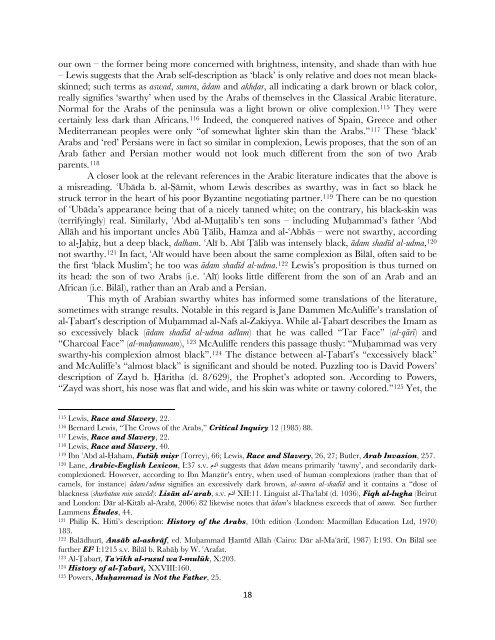“Anyone who says that the Prophet is black should be killed”: The ...
“Anyone who says that the Prophet is black should be killed”: The ...
“Anyone who says that the Prophet is black should be killed”: The ...
You also want an ePaper? Increase the reach of your titles
YUMPU automatically turns print PDFs into web optimized ePapers that Google loves.
our own – <strong>the</strong> former <strong>be</strong>ing more concerned with brightness, intensity, and shade than with hue<br />
– Lew<strong>is</strong> suggests <strong>that</strong> <strong>the</strong> Arab self-description as ‘<strong>black</strong>’ <strong>is</strong> only relative and does not mean <strong>black</strong>skinned;<br />
such terms as aswad, sumra, §dam and akh∙ar, all indicating a dark brown or <strong>black</strong> color,<br />
really signifies ‘swarthy’ when used by <strong>the</strong> Arabs of <strong>the</strong>mselves in <strong>the</strong> Classical Arabic literature.<br />
Normal for <strong>the</strong> Arabs of <strong>the</strong> peninsula was a light brown or olive complexion. 115 <strong>The</strong>y were<br />
certainly less dark than Africans. 116 Indeed, <strong>the</strong> conquered natives of Spain, Greece and o<strong>the</strong>r<br />
Mediterranean peoples were only “of somewhat lighter skin than <strong>the</strong> Arabs.” 117 <strong>The</strong>se ‘<strong>black</strong>’<br />
Arabs and ‘red’ Persians were in fact so similar in complexion, Lew<strong>is</strong> proposes, <strong>that</strong> <strong>the</strong> son of an<br />
Arab fa<strong>the</strong>r and Persian mo<strong>the</strong>r would not look much different from <strong>the</strong> son of two Arab<br />
parents. 118<br />
A closer look at <strong>the</strong> relevant references in <strong>the</strong> Arabic literature indicates <strong>that</strong> <strong>the</strong> above <strong>is</strong><br />
a m<strong>is</strong>reading. #Ub§da b. al-‘§mit, <strong>who</strong>m Lew<strong>is</strong> descri<strong>be</strong>s as swarthy, was in fact so <strong>black</strong> he<br />
struck terror in <strong>the</strong> heart of h<strong>is</strong> poor Byzantine negotiating partner. 119 <strong>The</strong>re can <strong>be</strong> no question<br />
of #Ub§da’s appearance <strong>be</strong>ing <strong>that</strong> of a nicely tanned white; on <strong>the</strong> contrary, h<strong>is</strong> <strong>black</strong>-skin was<br />
(terrifyingly) real. Similarly, #Abd al-Muããalib’s ten sons – including MuÈammad’s fa<strong>the</strong>r #Abd<br />
All§h and h<strong>is</strong> important uncles Abå •§lib, Hamza and al-#Abb§s – were not swarthy, according<br />
to al-JaÈií, but a deep <strong>black</strong>, dalham. #AlÊ b. AbÊ •§lib was intensely <strong>black</strong>, §dam shadÊd al-udma, 120<br />
not swarthy. 121 In fact, #AlÊ would have <strong>be</strong>en about <strong>the</strong> same complexion as Bil§l, often said to <strong>be</strong><br />
<strong>the</strong> first ‘<strong>black</strong> Muslim’; he too was §dam shadÊd al-udma. 122 Lew<strong>is</strong>’s proposition <strong>is</strong> thus turned on<br />
its head: <strong>the</strong> son of two Arabs (i.e. #AlÊ) looks little different from <strong>the</strong> son of an Arab and an<br />
African (i.e. Bil§l), ra<strong>the</strong>r than an Arab and a Persian.<br />
Th<strong>is</strong> myth of Arabian swarthy whites has informed some translations of <strong>the</strong> literature,<br />
sometimes with strange results. Notable in th<strong>is</strong> regard <strong>is</strong> Jane Dammen McAuliffe’s translation of<br />
al-•abarÊ’s description of MuÈammad al-Nafs al-Zakiyya. While al-•abarÊ descri<strong>be</strong>s <strong>the</strong> Imam as<br />
so excessively <strong>black</strong> (§dam shadÊd al-udma adlam) <strong>that</strong> he was called “Tar Face” (al-q§rÊ) and<br />
“Charcoal Face” (al-muÈammam), 123 McAuliffe renders th<strong>is</strong> passage thusly: “MuÈammad was very<br />
swarthy-h<strong>is</strong> complexion almost <strong>black</strong>”. 124 <strong>The</strong> d<strong>is</strong>tance <strong>be</strong>tween al-•abarÊ’s “excessively <strong>black</strong>”<br />
and McAuliffe’s “almost <strong>black</strong>” <strong>is</strong> significant and <strong>should</strong> <strong>be</strong> noted. Puzzling too <strong>is</strong> David Powers’<br />
description of Zayd b. \§ritha (d. 8/629), <strong>the</strong> <strong>Prophet</strong>’s adopted son. According to Powers,<br />
“Zayd was short, h<strong>is</strong> nose was flat and wide, and h<strong>is</strong> skin was white or tawny colored.” 125 Yet, <strong>the</strong><br />
115 Lew<strong>is</strong>, Race and Slavery, 22.<br />
116 Bernard Lew<strong>is</strong>, “<strong>The</strong> Crows of <strong>the</strong> Arabs,” Critical Inquiry 12 (1985) 88.<br />
117 Lew<strong>is</strong>, Race and Slavery, 22.<br />
118 Lew<strong>is</strong>, Race and Slavery, 40.<br />
119 Ibn #Abd al-\aham, FutåÈ mißr (Torrey), 66; Lew<strong>is</strong>, Race and Slavery, 26, 27; Butler, Arab Invasion, 257.<br />
120 Lane, Arabic-Engl<strong>is</strong>h Lexicon, I:37 s.v. ﻡﺩﺍ suggests <strong>that</strong> §dam means primarily ‘tawny’, and secondarily darkcomplexioned.<br />
However, according to Ibn Maníår’s entry, when used of human complexions (ra<strong>the</strong>r than <strong>that</strong> of<br />
camels, for instance) §dam/udma signifies an excessively dark brown, al-sumra al-shadÊd and it contains a “dose of<br />
<strong>black</strong>ness (shurbatun min saw§d): L<strong>is</strong>§n al-#arab, s.v. ﻡﺩﺍ XII:11. Lingu<strong>is</strong>t al-Tha#labÊ (d. 1036), Fiqh al-lugha (Beirut<br />
and London: D§r al-Kit§b al-ArabÊ, 2006) 82 likew<strong>is</strong>e notes <strong>that</strong> §dam’s <strong>black</strong>ness exceeds <strong>that</strong> of sumra. See fur<strong>the</strong>r<br />
Lammens Études, 44.<br />
121 Philip K. Hitti’s description: H<strong>is</strong>tory of <strong>the</strong> Arabs, 10th edition (London: Macmillan Education Ltd, 1970)<br />
183.<br />
122 Bal§dhurÊ, Ans§b al-ashr§f, ed. MuÈammad \amÊd All§h (Cairo: D§r al-Ma#§rif, 1987) I:193. On Bil§l see<br />
fur<strong>the</strong>r EI2 I:1215 s.v. Bil§l b. Rab§È by W. #Arafat.<br />
123 Al-•abarÊ, Ta"rÊkh al-rusul wa"l-mulåk, X:203.<br />
124 H<strong>is</strong>tory of al-•abarÊ, XXVIII:160.<br />
125 Powers, MuÈammad <strong>is</strong> Not <strong>the</strong> Fa<strong>the</strong>r, 25.<br />
18
















